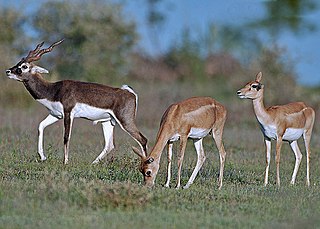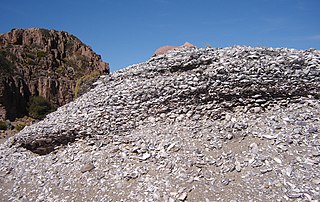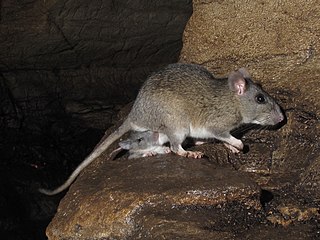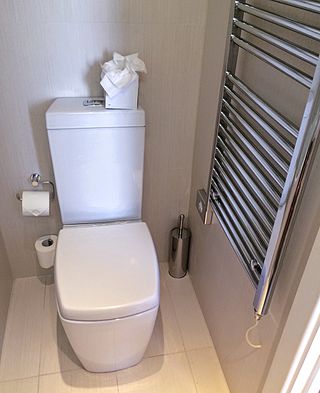Related Research Articles

Aardvarks are medium-sized, burrowing, nocturnal mammals native to Africa. They have a long snout, similar to that of a pig, which is used to sniff out food.

The term antelope refers to numerous extant or recently extinct species of the ruminant artiodactyl family Bovidae that are indigenous to most of Africa, India, the Middle East, Central Asia, and a small area of Eastern Europe. Antelopes do not form a monophyletic group, as some antelopes are more closely related to other bovid groups, like bovines, goats, and sheep, than to other antelopes.

A nest is a structure built for certain animals to hold eggs or young. Although nests are most closely associated with birds, members of all classes of vertebrates and some invertebrates construct nests. They may be composed of organic material such as twigs, grass, and leaves, or may be a simple depression in the ground, or a hole in a rock, tree, or building. Human-made materials, such as string, plastic, cloth, or paper, may also be used. Nests can be found in all types of habitat.

Sanitation refers to public health conditions related to clean drinking water and treatment and disposal of human excreta and sewage. Preventing human contact with feces is part of sanitation, as is hand washing with soap. Sanitation systems aim to protect human health by providing a clean environment that will stop the transmission of disease, especially through the fecal–oral route. For example, diarrhea, a main cause of malnutrition and stunted growth in children, can be reduced through adequate sanitation. There are many other diseases which are easily transmitted in communities that have low levels of sanitation, such as ascariasis, cholera, hepatitis, polio, schistosomiasis, and trachoma, to name just a few.

Animal husbandry is the branch of agriculture concerned with animals that are raised for meat, fibre, milk, or other products. It includes day-to-day care, management, production, nutrition, selective breeding, and the raising of livestock. Husbandry has a long history, starting with the Neolithic Revolution when animals were first domesticated, from around 13,000 BC onwards, predating farming of the first crops. By the time of early civilisations such as ancient Egypt, cattle, sheep, goats, and pigs were being raised on farms.

A midden is an old dump for domestic waste. It may consist of animal bones, human excrement, botanical material, mollusc shells, potsherds, lithics, and other artifacts and ecofacts associated with past human occupation.

The Bhimbetka rock shelters are an archaeological site in central India that spans the Paleolithic and Mesolithic periods, as well as the historic period. It exhibits the earliest traces of human life in India and evidence of the Stone Age starting at the site in Acheulian times. It is located in the Raisen District in the Indian state of Madhya Pradesh, about 45 kilometres (28 mi) south-east of Bhopal. It is a UNESCO World Heritage Site that consists of seven hills and over 750 rock shelters distributed over 10 km (6.2 mi). At least some of the shelters were inhabited more than 100,000 years ago.

A pit latrine, also known as pit toilet, is a type of toilet that collects human waste in a hole in the ground. Urine and feces enter the pit through a drop hole in the floor, which might be connected to a toilet seat or squatting pan for user comfort. Pit latrines can be built to function without water or they can have a water seal. When properly built and maintained, pit latrines can decrease the spread of disease by reducing the amount of human feces in the environment from open defecation. This decreases the transfer of pathogens between feces and food by flies. These pathogens are major causes of infectious diarrhea and intestinal worm infections. Infectious diarrhea resulted in about 700,000 deaths in children under five years old in 2011 and 250 million lost school days. Pit latrines are a low-cost method of separating feces from people.

The saiga antelope, or saiga, is a species of antelope which during antiquity inhabited a vast area of the Eurasian steppe, spanning the foothills of the Carpathian Mountains in the northwest and Caucasus in the southwest into Mongolia in the northeast and Dzungaria in the southeast. During the Pleistocene, it ranged across the mammoth steppe from the British Isles to Beringia. Today, the dominant subspecies only occurs in Kalmykia and Astrakhan Oblast of Russia and in the Ural, Ustyurt and Betpak-Dala regions of Kazakhstan. A portion of the Ustyurt population migrates south to Uzbekistan and occasionally to Turkmenistan in winter. It is regionally extinct in Romania, Ukraine, Moldova, China and southwestern Mongolia. The Mongolian subspecies occurs only in western Mongolia.

The dibatag, or Clarke's gazelle, is a medium-sized slender antelope native to Ethiopia and Somalia. Though not a true gazelle, it is similarly marked, with long legs and neck. It is often confused with the gerenuk due to their striking resemblance. The typical head-and-body length is about 103 to 117 cm. They stand up to about 80 to 90 cm. Male dibatag weigh between 20 and 35 kg, whereas females range from 22 and 29 kg. The length of the curved horns, present only on males, is typically between 10 and 25 cm. The upper parts are gray to fawn, while the dorsal and lateral areas are cinnamon to rufous. The underparts, rump and the insides of the legs are all white. While markings are visible on the face, there are none on the flanks or the buttocks.

The eastern woodrat, also known as the Florida woodrat or bush rat, is a pack rat native to the central and Eastern United States. It constructs large dens that may serve as nests for many generations and stores food in outlying caches for the winter. While widespread and not uncommon, it has declined or disappeared in several areas.

The Allegheny woodrat, is a species of "pack rat" in the genus Neotoma. Once believed to be a subspecies of the eastern woodrat, extensive DNA analysis has proven it to be a distinct species.

Dung middens, also known as dung hills, are piles of dung that mammals periodically return to and build up. They are used as a form of territorial marker. A range of animals are known to use them including steenbok, hyrax, and rhinoceros. Other animals are attracted to middens for a variety of purposes, including finding food and locating mates. Some species, such as the dung beetle genus Dicranocara of the Richtersveld in South western Africa spend their whole lifecycle in close association with dung middens. Dung middens are also used in the field of Paleobotany, which relies on the fact that each ecosystem is characterized by certain plants, which in turn act as a proxy for climate. Dung middens are useful as they often contain pollen which means fossilized dung middens can be used in paleobotany to learn about past climates.

Mokala National Park is a reserve established in the Plooysburg area south-west of Kimberley in the Northern Cape, South Africa on 19 June 2007. The size of the park is 26,485 hectares. Mokala is the Setswana name for the magnificent camel thorn, a tree species typical of the arid western interior and common in the area. There is currently 70 km of accessible roads in the national park.

The raccoon, also spelled racoon and sometimes called the common raccoon or northern raccoon to distinguish it from the other species, is a mammal native to North America. It is the largest of the procyonid family, having a body length of 40 to 70 cm, and a body weight of 5 to 26 kg. Its grayish coat mostly consists of dense underfur, which insulates it against cold weather. The animal's most distinctive features include its extremely dexterous front paws, its facial mask, and its ringed tail, which are common themes in the mythologies of the Indigenous peoples of the Americas surrounding the species. The raccoon is noted for its intelligence, and studies show that it is able to remember the solution to tasks for at least three years. It is usually nocturnal and omnivorous, eating about 40% invertebrates, 33% plants, and 27% vertebrates.

A pack rat or packrat, also called a woodrat or trade rat, are any species in the North and Central American rodent genus Neotoma. Pack rats have a rat-like appearance, with long tails, large ears, and large, black eyes. Pack rats are noticeably larger than deer mice, harvest mice, and grasshopper mice, and are usually somewhat larger than cotton rats.

A toilet is a piece of sanitary hardware that collects human urine and feces, and sometimes toilet paper, usually for disposal. Flush toilets use water, while dry or non-flush toilets do not. They can be designed for a sitting position popular in Europe and North America with a toilet seat, with additional considerations for those with disabilities, or for a squatting posture more popular in Asia, known as a squat toilet. In urban areas, flush toilets are usually connected to a sewer system; in isolated areas, to a septic tank. The waste is known as blackwater and the combined effluent, including other sources, is sewage. Dry toilets are connected to a pit, removable container, composting chamber, or other storage and treatment device, including urine diversion with a urine-diverting toilet.

Hebeloma radicosum, commonly known as the rooting poison pie, is a species of agaric fungus in the family Hymenogastraceae. Fruit bodies (mushrooms) can be identified by the tapering root-like stipe base, as well as the almond-like odor.

A pail closet or pail privy or dirt closet was a room used for the disposal of human excreta, under the "pail system" of waste removal. The "closet" was a small outhouse (privy) which contained a seat, underneath which a portable receptacle was placed. This bucket (pail), into which the user would defecate, was removed and emptied by the local authority on a regular basis. The contents, known euphemistically as night soil, would either be incinerated or composted into fertiliser.

Puhú was a major residential village in the Santa Ana Mountains shared by the Tongva, Acjachemen, Payómkawichum, and Serrano near Santiago Peak. The village resided approximately 600m above sea level in the upper areas of the Black Star Canyon. The village was at its height from the years 1220–1770. The village retained its multi-seasonal occupancy and economic and political systems up until its destruction and a communal massacre in 1832.
References
- 1 2 3 4 5 McGreevy, Paul, ed. (2012). Equine Behavior: A Guide for Veterinarians and Equine Scientists (2nd ed.). Elsevier. p. 211. ISBN 978-0702043376.
- ↑ "Mammalogy", ISBN 0763762997, p. 562
- 1 2 Chase, B.M.; Meadows, M.E.; Scott, L.; Thomas, D.S.G.; Marais, E.; Sealy, J.; Reimer, P.J. (2009). "A record of rapid Holocene climate change preserved in hyrax middens from southwestern Africa". Geology. 37 (8): 703–706. Bibcode:2009Geo....37..703C. doi:10.1130/G30053A.1.
- 1 2 Sagara N, Senn-Irlet B, Marstad P (2006). "Establishment of the case of Hebeloma radicosum growth on the latrine of the wood mouse". Mycoscience. 47 (5): 263–8. doi:10.1007/s10267-006-0303-y. S2CID 85310185.
- ↑ "On the Fruit Consumption of Eurasian Badger (Meles meles) (Mammalia: Mustelidae) during the Autumn Season in Sredna Gora Mountains (Bulgaria)" . Retrieved 2014-01-03.
- 1 2 3 "Giant prehistoric toilet unearthed", James Morgan, science reporter, BBC News , 28 November 2013
- 1 2 George B. Schaller, "The Deer and the Tiger", p. 164
- 1 2 3 4 "The role of small antelope in ecosystem functioning in the Matobo hills, Zimbabwe" Archived December 30, 2013, at the Wayback Machine
- ↑ Lee Curtis (2012). Queensland's Threatened Animals. Csiro Publishing. p. 224. ISBN 9780643104570 . Retrieved 2014-01-03.
- ↑ Dewey, Tanya. "ADW: Moloch horridus: INFORMATION". Animaldiversity.ummz.umich.edu. Retrieved 2014-01-03.
- ↑ Sneddon I.A. Latrine use by the European rabbit (Oryctolagus-Cuniculus). J Mammal 1991;72:769–775 doi : 10.2307/1381841
- ↑ Yukie Sato, Yutaka Saito, "Nest Sanitation in Social Spider Mites: Interspecific Differences in Defecation Behavior", doi : 10.1111/j.1439-0310.2005.01184.x
- ↑ "Livestock grazing behavior and inter- versus intraspecific disease risk via the fecal–oral route"
- ↑ "Inspecting for Raccoon Damage". Archived from the original on 2013-12-30. Retrieved 2013-12-30.
- ↑ "Nuisance Animals Around The Home". Archived from the original on 2013-10-23. Retrieved 2013-12-30.
- ↑ "Raccoon Latrines: Identification and Clean-up", a Centers for Disease Control and Prevention webpage
- ↑ "50,000 Year Old Animal Toilet Offers Clues To Climate Change History", International Business Times, February 19, 2013
- ↑ Sagara N, Ooyama J, Koyama M (2008). "New causal animal for the growth of Hebeloma radicosum (Agaricales): shrew, Sorex sp (Mammalia, Insectivora)". Mycoscience. 49 (3): 207–10. doi:10.1007/s10267-008-0407-7. S2CID 83999856.
- ↑ Jeremy Hollmann (1997). "Information Needed About the Aardvark Cucumber (Cucumis humofructus)". BGCNews. 2 (8). Archived from the original on 2015-02-11. Retrieved 2014-06-01.